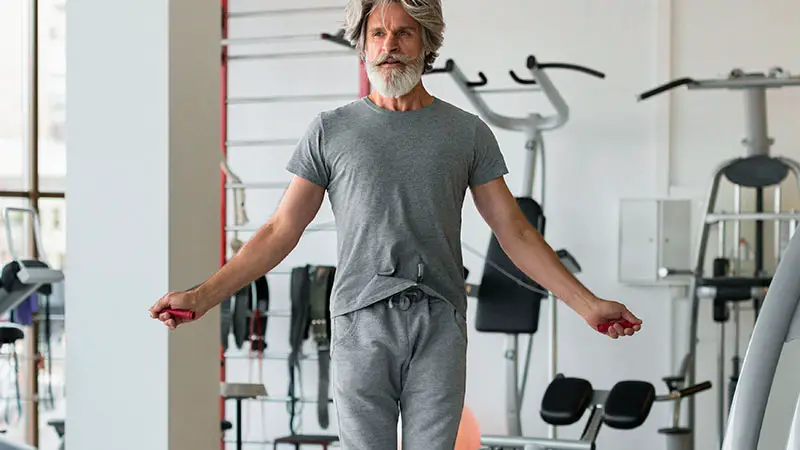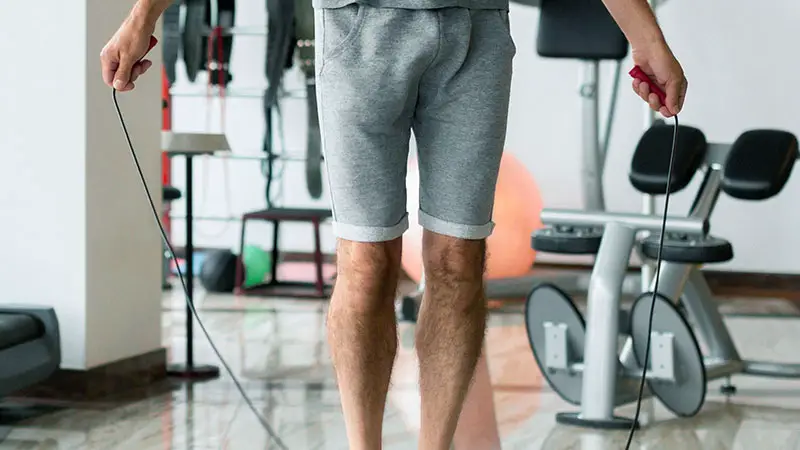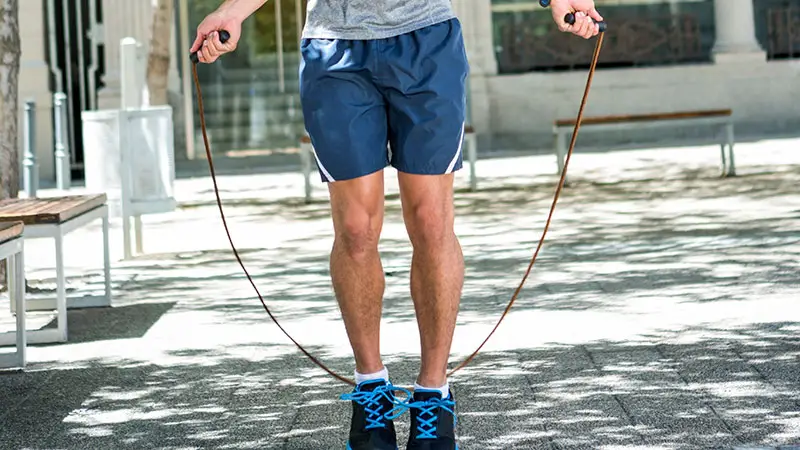Looking to add a little bounce to your exercise routine? Jump rope isn’t just for kids on the playground. It’s a fun and effective workout for seniors too, offering a host of health benefits.
From improving cardiovascular health and balance to boosting bone density, there’s more to this nostalgic activity than meets the eye.
Whether you’re a seasoned skipper or just starting out, we’ve got you covered. This article will guide you through 10 jump rope workouts tailored for seniors.
You’ll learn everything from basic two-foot jumps to more advanced techniques like double unders. So grab your rope, and let’s get jumping!
Remember, it’s not about how high you jump, but how much fun you’re having while getting fit. So, are you ready to hop into a healthier lifestyle?

Benefits of Jump Rope Workouts for Seniors
Jump rope workouts offer numerous benefits for seniors, including:
Improves Cardiovascular Health
Jump rope workouts are a superb way to get your heart pumping. Regular skipping can help reduce the risk of heart diseases by improving your cardiovascular health. Take it slow and steady – try basic jumps for 20 seconds, followed by a 10-second rest. Repeat.
Boosts Mental Health
Aerobic exercises like jump rope workouts can also have a positive impact on your mental health. According to scientific studies, physical activity can help reduce symptoms of depression and anxiety.
Enhances Balance and Coordination
As you age, you’ll notice balance and coordination may not be as sharp as they once were. Jumping rope aids in both. Focus on different types of jumps, alternating between your right and left foot, for instance, to improve coordination.
Increases Bone Density
Weight-bearing exercises, like jump rope workouts, play a key role in preventing age-related bone loss. Try alternating bodyweight lunges or side-to-side jumps to stimulate bone building.
Promotes Weight Loss
If you’re looking to shed a few pounds, jumping rope can help. High knee jumps, pushups, and burpees – integrated into your jump rope routine – could increase calorie burning.
How to Master the Right Jumping Rope Form?

Embarking on your jump rope journey? Let’s break down the essentials of mastering the perfect jump rope form.
A proper form eases your workout, reduces injuries, and strengthens your skills across a multitude of jump rope exercises. Here’s how you to do it:
Start With the Traditional Stance
Stand tall, with your body straight and eyes peeled forward, placing your feet hip-width apart. Maintain the balance of your weight slightly forward on the balls of your feet. Do ensure your knees are slightly bent.
Swing the Rope Using your Wrists
Your hands should be positioned slightly above your waistline, and close to your body during your swings. Remember, it’s your wrists that control and propel the rope, not your elbows or shoulders.
Perform the Side Swings
Swing the rope to either side of your body instead of jumping over it. To do this, both your hands should move to one side of your body while swinging the rope. This helps maintain your momentum and forms a base for learning advanced skills.
Try the Mummy Kick Jump
Once you’ve mastered basic jumps, add a bit of flare. Keep the standard stance and form, initiate with the rope behind you. As it moves over your head, kick one foot out mimicking a mummy’s walk. This adds emphasis to your quads and calves, spicing up your routine.
Rotate the Rope in the Correct Direction
To avoid tangling, always be aware of the rope’s rotation. Most basic ropes have 180-degree intrahandle rotation. Speed ropes may have 90-degree angle attachments to prevent torque that can damage the rope or intrude in your routine.
Test and Adapt Your Jumping Speed
Practice varying speeds and rhythms to find what’s comfortable and beneficial. It’s normal for speed ropes to feel different at slower speeds. Find a balance between speed and control that suits your workout.
Choose the Right Rope
Not all ropes are made equal. If your rope is heavy, it may require more muscular effort. If it kinks or can’t be adjusted to your height, it may obstruct your workout. Find a rope that suits your physical condition and workout goals.
Selecting the Best Jump Rope for Seniors
Choosing the right jump rope can greatly influence your workout experience. Let’s delve into different jump rope workouts that can help seniors stay fit, agile, and healthy.
1. The Basic Jump Workout

Kick off your jump rope journey with basic jumps. It’s an essential, often used exercise, especially with a heavy jump rope.
If you’re new to jump rope exercises, we suggest you start with this technique to get used to the rhythm and movement.
After mastering basic jumps, try alternate foot jumps for cardio. Next, explore side swings to improve coordination.
High knee jumps can enhance leg strength while a single leg jump boosts balance. Crisscross and double under are advanced exercises that aid agility and endurance.
Keep safety in mind; always warm up before starting your routine and wear appropriate footwear.
2. Alternate Foot Step Jump Workout

Next in line is the Alternate Foot Step Jump Workout. It’s a potent routine often integrated into high-intensity jump rope workouts and weight loss fitness challenges.
The goal is to maximize your pace using a heavy rope, enhancing your workout’s intensity. This workout targets your lower body muscles, boosting agility and stamina.
It’s particularly beneficial for seniors as it promotes cardiovascular health and joint flexibility. However, remember to maintain proper form to avoid injuries.
3. Boxer Step Jump Workout

The Boxer Step Jump has long been a go-to exercise for boxers. It allows you to jump for extended periods as you shift your weight from one foot to the other, thereby improving your endurance and cardio health.
Additionally, the Boxer Step Jump also enhances your balance and agility, crucial for seniors aiming to maintain their physical mobility. Incorporating this jump rope workout in your routine can lead to improved overall fitness levels.
4. High Knees Jump Workout

Also known as High Knees, this workout helps turbocharge your heart rate, paving the way for a fat-burning jump rope regimen.
It enhances the intensity of your workout and is a step-up from the alternate footstep jump. The Jumping Jacks workout is another excellent choice for seniors.
It boosts cardiovascular fitness while improving flexibility and coordination. Ending your routine with a slow-paced Cool Down jump ensures muscle relaxation, reducing injury risk.
5. Jumping Jacks Rope Workout

Jump rope jacks are suitable for all fitness levels. Not only do they enhance your coordination, but they also add a fun element to your basic jumps.
Incorporating jump rope jacks into your routine boosts cardio fitness, improves balance, and strengthens lower body muscles.
Seniors can modify the intensity based on their comfort level while still reaping significant health benefits.
6. Mummy Kicks Jump Workout

Mummy Kick Jump is an advanced technique often used in professional fitness sessions. It involves alternating kicks with each turn of the rope, increasing the workout’s intensity and engaging more muscle groups.
Furthermore, it boosts cardiovascular health and improves overall coordination. However, always remember to maintain the right form during this workout to avoid injuries. Start slow and gradually increase your pace as strength builds up.
7. Criss-Cross Jump Workout

The Criss-Cross Jump workout involves crossing your arms on alternate beats as you jump, forcing your upper body muscles to work harder.
It helps to improve hand-eye coordination and tones your upper body. The Boxer Step Jump workout engages your lower body, enhancing balance and agility.
This routine, often used by boxers for endurance training, is ideal for seniors looking to boost their cardiovascular health.
8. Side Swing Jump Rope Workout

In the Side Swing workout, you swing the rope from one side of your body to the other. It’s a fantastic way to increase arm strength while boosting your concentration and coordination skills.
In addition, this workout aids in enhancing your cardiovascular health and flexibility. It’s a low-impact exercise that seniors can easily adapt to, making it an excellent option for maintaining fitness levels as you age.
9. Under Jump Workout

The Under Jump workout involves bringing the rope continually under your feet with each jump. This exercise helps to increase your jumping speed, promoting agility and cardiovascular health.
Moreover, it’s an excellent way to enhance coordination and balance, crucial for seniors to prevent falls. The Under Jump workout is easily adaptable to one’s fitness level, making it ideal for all seniors.
10. Half and Full Twist Jump Workout

Last on our list is the Half and Full Twist Jump Workout. It requires you to turn your body halfway or entirely with each jump, making it a dynamic and challenging routine that improves body coordination and balance.
Importantly, this routine also enhances agility and fosters flexibility. However, seniors should perform it under supervision to prevent injuries. With time, they can experience increased endurance and a more robust cardiovascular system.
Tips to Safely Increase Intensity in Jump Rope Workouts
To safely increase intensity in jump rope workouts, consider the following tips from the provided sources:
Prioritize a Thorough Warm-Up
Before starting any intense activity, warm up to prepare your muscles. Examples might include a short jog or jumping jacks. You could also include dynamic warm-up exercises like walking lunges, walking toe touches, and skips.
Gradually Extend Workout Timings
Start with shorter durations such as 20 seconds of jumps followed by 10 seconds of rest. As you get comfortable, you can safely increase the duration of each workout segment.
Incorporate Variety into Your Exercises
Regularly alternate between different types of jumps. A mix of Standard jumps, Right foot hops, Left foot hops, and High knee jumps can help to gradually increase intensity without overburdening your muscles.
Add Resistance Training
Combine your jumping rope workout with bodyweight exercises such as squats or lunges. These additional exercises not only intensify your workout but also promote muscular strength and endurance.
Follow a Pace That Suits Your Fitness Level
Remember, you’re not in a race. It’s crucial to adopt a pace that’s suitable for your fitness level. Over time, as your endurance builds, you can safely increase the intensity.
Remember, it’s all about balance. You don’t have to push yourself too hard too quickly. Keep it enjoyable yet challenging, and you’ll see the improvements in your agility, strength, and overall fitness in no time.
Frequently Asked Questions
Why should seniors consider jump rope exercises?
Jump rope exercises can significantly boost seniors’ cardiovascular health, balance, bone density, and mental well-being. They’re adaptable to various fitness levels, allowing gradual intensity increase and enjoyable workout variations.
What jump rope workouts are suitable for seniors?
Seniors can engage in a range of jump rope workouts, from basic jumps to advanced techniques like the Mummy Kick Jump and Criss-Cross Jump. The key is to start basic and progressively increase intensity based on individual fitness levels.
What should be considered when selecting a jump rope for seniors?
Choosing the right jump rope is crucial. It should match the user’s height for safety and efficiency. Also, being mindful of the workout environment can help avoid accidents and maximize the benefits of the exercises.
How should seniors incorporate jump rope exercises into their routine?
Seniors can start with basic jumps and gradually increase intensity with exercises like high-knee jumps and side-to-side jumps. It’s essential to pace according to fitness level, listen to body signals, incorporate rest intervals, and balance benefit-focused and fun workouts.
How can jump rope exercises enhance agility, strength, and overall fitness for seniors?
Jump rope exercises encompass elements of cardio, strength, flexibility, and balance. Consequently, they contribute to enhanced agility, improved strength, and overall fitness, making them an ideal all-round exercise option for seniors.
Conclusion
So, you’ve learned that jump rope workouts are a fantastic way for seniors to boost their health and fitness. Whether it’s basic jumps or the more advanced Mummy Kick Jump and Criss-Cross Jump, there’s something for every skill level.
Remember, it’s not just about the type of workout but also choosing the right jump rope and creating a safe environment.
Start slow, listen to your body and incorporate rest intervals. It’s all about finding the right balance between workouts that are beneficial and those that bring joy.
With these workouts, you’re on your way to improved agility, strength, and overall fitness. So why wait? Grab your jump rope and get started on your journey to a healthier you today!
I am a fitness instructor and I have been in the industry for 9 years. I have a passion for health and fitness.
I am a fitness instructor with over 9 years of experience in the industry. My passion is health and fitness and I would love to share my knowledge with you!